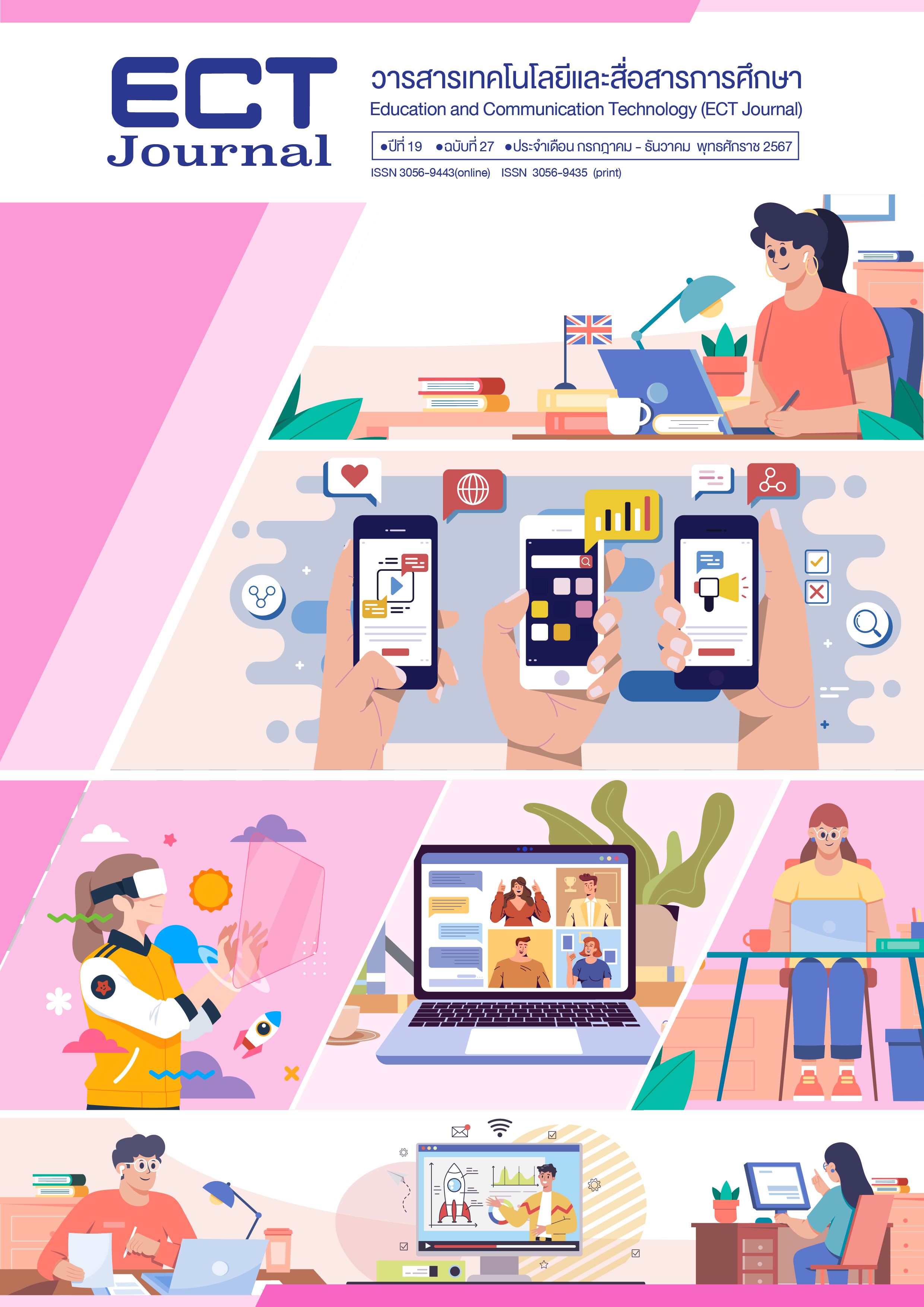การศึกษาสภาพและความต้องการรูปแบบการเรียนรู้ ในความเป็นจริงเสมือนบนฐานการเเก้ปัญหาเชิงสร้างสรรค์ที่ส่งเสริม ความสามารถทางนวัตกรรมของนักศึกษาปริญญาบัณฑิต
คำสำคัญ:
การเรียนรู้ในความเป็นจริงเสมือน, การเเก้ปัญหาเชิงสร้างสรรค์, ความสามารถทางนวัตกรรมบทคัดย่อ
การวิจัยในครั้งนี้มีวัตถุประสงค์เพื่อศึกษาสภาพและความต้องการรูปแบบการเรียนรู้ในความเป็นจริงเสมือนบนฐานการเเก้ปัญหาเชิงสร้างสรรค์ที่ส่งเสริมความสามารถทางนวัตกรรมของนักศึกษาปริญญาบัณฑิต ตัวอย่าง คือ นักศึกษาปริญญาบัณฑิต จากการคำนวณด้วยสูตรของ Cochran (1977) รวมจำนวน 416 คน เครื่องมือที่ใช้ในการวิจัย ได้แก่ 1) แบบสอบถามสภาพและความต้องการฯ 2) แบบประเมินความตรงเชิงเนื้อหาของแบบสอบถาม โดยวิเคราะห์ข้อมูลด้วยสถิติบรรยายในการหาค่าร้อยละ ค่าเฉลี่ย ค่าส่วนเบี่ยงเบนมาตรฐาน และวิเคราะห์หาสภาพและความต้องการรูปแบบการเรียนรู้ฯ จากการหาดัชนีการจัดเรียงลำดับความสำคัญของความจำเป็น (PNI Modified) ผลการวิจัย พบว่า
1. สภาพการใช้ความเป็นจริงเสมือนของนักศึกษาปริญญาบัณฑิต พบว่า นักศึกษาส่วนใหญ่รู้จักความเป็นจริงเสมือน (ร้อยละ 89.66) และเคยใช้งานความเป็นจริงเสมือนมาก่อน (ร้อยละ 87.74)
2. พฤติกรรมการใช้เทคโนโลยีและแอปพลิเคชันต่างๆ พบว่า นักศึกษาใช้งานอินเทอร์เน็ตโดยเฉลี่ยประมาณ 11 ชั่วโมงต่อวัน (ค่าเฉลี่ยที่ 11.20) และส่วนใหญ่เข้าอินเทอร์เน็ตผ่านสมาร์ตโฟน (ร้อยละ 85.10) ทั้งนี้นักศึกษามีความสามารถในการใช้งานแอปพลิเคชันการทำงานที่หลากหลายโดยมีค่าเฉลี่ยมากกว่าร้อยละ 90
3. ความต้องการรูปแบบการเรียนรู้ในความเป็นจริงเสมือนฯ แบ่งออกเป็น 3 ด้าน ได้แก่ 1) ด้านการเรียนรู้ในความเป็นจริงเสมือน (VR) 2) ด้านการเรียนรู้บนฐานการแก้ปัญหาเชิงสร้างสรรค์ (CPS) 3) ด้านการเรียนรู้ที่ส่งเสริมความสามารถทางนวัตกรรม (IC) โดยผลการศึกษาพบว่า นักศึกษามีความต้องการที่จะได้รับประสบการณ์การใช้ความเป็นจริงเสมือนในการเรียน (PNI Modified = 0.72) เป็นอันดับแรก รองลงมาคือรับประสบการณ์การใช้ความเป็นจริงเสมือนในการเรียนที่ต้องแสดงความคิดสร้างสรรค์และความสามารถทางนวัตกรรม (PNI Modified = 0.61) รับประสบการณ์การเรียนรู้โดยการสวมบทบาทเป็นอวตารบนความเป็นจริงเสมือน (PNI Modified = 0.52) และ รับประสบการณ์การเรียนรู้ร่วมกับผู้อื่นบนความเป็นจริงเสมือน (PNI Modified = 0.52) ตามลำดับ อย่างไรก็ตามทั้ง 3 ข้อข้างต้นอยู่ในด้านการเรียนรู้ในความเป็นจริงเสมือนทั้งหมด ซึ่งแสดงให้เห็นถึงความสนใจและความต้องการในรูปแบบการเรียนรู้ที่ใช้ความเป็นจริงเสมือน
เอกสารอ้างอิง
โกศวัต รัตโนทยานนท์. (2561). การพัฒนารูปแบบคอมพิวเตอร์สนับสนุนการเรียนรู้ร่วมกันโดยใช้การเรียนรู้ด้วยปัญหาเป็นฐานและเทคนิคซินเนคติกส์เพื่อเสริมสร้างความสามารถทางนวัตกรรมของนักศึกษาปริญญาบัณฑิต [วิทยานิพนธ์ปริญญาดุษฎีบัณฑิต, จุฬาลงกรณ์มหาวิทยาลัย]. Chula Digital Theses. https://digital.car.chula.ac.th/chulaetd/2713/
จินตวีร์ คล้ายสังข์, และประกอบ กรณีกิจ. (2559). รายงานการวิจัย เรื่อง การวิจัยและพัฒนาโปรแกรมเสริมสำหรับระบบจัดการเรียนรู้ที่เน้นผลลัพธ์การเรียนรู้ในสภาพแวดล้อมอีเลิร์นนิงแบบผสมผสานศาสตร์การสอนสำหรับผู้เรียนระดับอุดมศึกษา. สำนักงานคณะกรรมการการอุดมศึกษา.
สาวิตรี สุทธิจักร์. (2562). การบ่มเพาะทักษะเชิงนวัตกรรมของนักศึกษาปริญญาตรีในคณะวิชาสร้างสรรค์ในประเทศไทย. วารสารครุศาสตร์ จุฬาลงกรณ์มหาวิทยาลัย, 47(1), 487-507. https://so02.tci-thaijo.org/index.php/EDUCU/article/view/179873
สำนักงานสภาพัฒนาการเศรษฐกิจและสังคมแห่งชาติ. (2560). ยุทธศาสตร์ชาติ พ.ศ. 2561-2580 (ฉบับย่อ). https://www.nesdc.go.th/download/document/SAC/NS_SumPlanOct2018.pdf
สำนักงานพัฒนาธุรกรรมทางอิเล็กทรอนิกส์. (2563). รายงานผลการสำรวจพฤติกรรมผู้ใช้อินเทอร์เน็ตในประเทศไทย ปี 2563. https://www.etda.or.th/th/UsefulResource/publications/Thailand-Internet-User-Behavior-2020.aspx
สุวิมล ว่องวาณิช. (2558). การวิจัยประเมินความต้องการจำเป็น. สำนักพิมพ์แห่งจุฬาลงกรณ์มหาวิทยาลัย.
Cilliers, E. (2017). The challenge of teaching generation Z. People. International Journal of Social Sciences, 3, 188-198. https://doi.org/10.20319/pijss.2017.31.188198
Han, S., & Noh, Y. (2021). Analyzing higher education instructors' perception on Metaverse-based education. Journal of Digital Contents Society, 22(11), 1793-1806. https://doi.org/10.9728/dcs.2021.22.11.1793
Hu, R., Wu, Y.-Y., & Shieh, C.-J. (2016). Effects of virtual reality integrated creative thinking instruction on students' creative thinking abilities. Eurasia Journal of Mathematics, Science and Technology Education, 12, 477-486. https://doi.org/10.12973/eurasia.2016.1226a
Iddris, F. (2016). Innovation capability: A systematic review and research agenda. Journal of Information, Knowledge, and Management, 11, 235-260. https://doi.org/10.28945/3571
Kanematsu, H., Fukumura, Y., Ogawa, N., Okuda, A., Taguchi, R., Nagai, H., & Barry, M. M. (2009). Problem based learning in Metaverse as a digitized synchronous type learning. Journal of Information, Knowledge, and Management, 11, 235-260. https://doi.org/10.28945/3571
Kemp, S. (2023). Digital 2023: Thailand. DataReportal. https://datareportal.com/reports/digital-2023-thailand
Lawson, B., & Samson, D. (2001). Developing innovation capability in organisations: A dynamic capabilities approach. International Journal of Innovation Management, 5, 377-400. https://doi.org/10.1142/S1363919601000427
Lee, J. (2022). A study on the intention and experience of using the metaverse. Journal of Arts and Humanities Research, 13(1), 177-192. https://doi.org/10.21860/j.13.1.10
Lo, M. F., & Tian, K. (2019). Enhancing competitive advantage in Hong Kong higher education: Linking knowledge sharing, absorptive capacity and innovation capability. Higher Education Quarterly, 74. https://doi.org/10.1111/hequ.12244
McGovern, E., Moreira, G., & Luna-Nevarez, C. (2019). An application of virtual reality in education: Can this technology enhance the quality of students' learning experience?. Journal of Education for Business, 95, 1-7. https://doi.org/10.1080/08832323.2019.1703096
Mendoza Silva, A. (2020). Innovation capability: A systematic literature review. European Journal of Innovation Management, 24(3), 707-734. https://doi.org/10.1108/EJIM-09-2019-0263
Nicholas, A. J. (2020). Preferred learning methods of Generation Z [Faculty and Staff Articles & Papers]. Salve Regina University. https://digitalcommons.salve.edu/fac_staff_pub/74
Park, S.-M., & Kim, Y.-G. (2022). A metaverse: Taxonomy, components, applications, and open challenges. IEEE Access, 10, 4209-4251. https://doi.org/10.1109/ACCESS.2021.3140175
Saorín, J., Cantero, J., Melián Díaz, D., & Carbonell, C. (2020). Minecraft: Three-dimensional construction workshop for improvement of creativity. Technology, Pedagogy and Education, 29(5), 665-978. https://doi.org/10.1080/1475939X.2020.1814854
Seaman, C., LaPerla, J. T., Schwartz, E., & Bienstock, J. E. (2018). Common leadership characteristics, personality traits, and behaviors that generations X, Y, and Z leaders find effective for shared leadership: A formal, informal, and rational approach. Journal of International Management Studies, 18(3), 5-20.
The Department of Education, Employment and Workplace Relations. (2009). Developing innovation skills: A guide for trainers and assessors to foster the innovation skills of learners through professional practice. Innovation & Business Skills Australia Ltd.
United Nations. (2022). The sustainable development goals report 2022. https://unstats.un.org/sdgs/report/2022/The-Sustainable-Development-Goals-Report-2022.pdf
World Economic Forum. (2020). The future of jobs report 2020. https://www3.weforum.org/docs/WEF_Future_of_Jobs_2020.pdf
World Economic Forum. (2022). Future focus 2025: Pathways for progress from the Network of Global Future Councils 2020-2022. https://www3.weforum.org/docs/WEF_Future_Focus_2025.pdf
ดาวน์โหลด
เผยแพร่แล้ว
รูปแบบการอ้างอิง
ฉบับ
ประเภทบทความ
สัญญาอนุญาต
ลิขสิทธิ์ (c) 2024 มหาวิทยาลัยสุโขทัยธรรมาธิราช

อนุญาตภายใต้เงื่อนไข Creative Commons Attribution-NonCommercial-NoDerivatives 4.0 International License.
1. ทรรศนะและข้อคิดเห็นใด ๆ ที่ปรากฏอยู่ในวารสาร ECT Education and Communication Technology Journal เป็นของผู้เขียนโดยเฉพาะ สำนักเทคโนโลยีการศึกษา มหาวิทยาลัยสุโขทัยธรรมาธิราช และกองบรรณาธิการไม่จำเป็นต้องเห็นพ้องด้วย
2. กองบรรณาธิการของสงวนลิขสิทธิ์ในการบรรณาธิการข้อเขียนทุกชิ้น เพื่อความเหมาะสมในการจัดพิมพ์เผยแพร่






